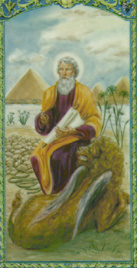Scientists could be close to deciphering world's most mysterious book
FREE Catholic Classes
A mysterious book filled with writings and images that some have dismissed as nonsense, may be close to decipherment after more than a century of mystery. A scientist now claims to have found linguistic patterns in the Voynich Book, a critical step in deciphering mysterious languages.
Highlights
Catholic Online (https://www.catholic.org)
6/24/2013 (1 decade ago)
Published in Europe
Keywords: Voynich Book, manuscript, book, mystery, scientists, writing, decipher, meaning, pictures
LOS ANGELES, CA (Catholic Online) - The book is about 600 years old and is written in a strange script that is unlike any known alphabet. The bizarre glyphs and their accompanying pictures have eluded decipherment for over a century. Even the finest code-breakers from World War I and II have not been able to unravel its meaning, and modern computer analysis has come up fruitless, leading many to dismiss the work as gibberish.
However, new research appears to show linguistic patterns, which could result in the decipherment of individual words.
The Voynich Book came to modern light in 1912 when it was purchased by Wilfrid Voynich, a book collector. The book was subsequently passed to different individuals and into the hands of Yale University in 1969 where it could be studied in detail.
Unable to decipher its meanings, many originally alleged the book to be a forgery, possibly created by Voynich himself, since such a book could be of great value. However, Voynich never sold the manuscript and it passed to his widow, who passed it to a friend, and then to a dealer who donated it to the university.
Testing by scientists has dated the book to sometime between 1404 and 1438. The inks used and various other indicators suggest the book is a genuine renaissance manuscript. The book is also written in the same style of other contemporary herbal books that contained remedies for various ailments.
The manuscript does not appear to be a period hoax either. In fact, it is far too painstaking to likely be a simple hoax. Many written hoaxes of the time, which certainly did exist, were much less sophisticated.
Based on analysis of the illustrations, the book appears to be a science book of some sort, complete with herbal remedies, astronomical understandings, and vivid illustrations. The handwritten work existed about a century before the European invention of the printing press and today is about 240 pages in length. Several pages are missing and experts think it may have once contained as many as 272 pages.
The book is exceptionally bizarre. In addition to being composed in an entirely unknown and undecipherable script, the illustrations add to the mystery. Many plants appear fanciful or are hybrids of existing plants, for example, the root structures do not match the plants drawn above them.
Marcelo Montemurro, a theoretical physicist from the University of Manchester says he may have found a clue that could someday unlock the book's mysteries. Publishing in the journal Plos One, he said the linguistics have "significant structure."
We ask you, humbly: don't scroll away.
Hi readers, it seems you use Catholic Online a lot; that's great! It's a little awkward to ask, but we need your help. If you have already donated, we sincerely thank you. We're not salespeople, but we depend on donations averaging $14.76 and fewer than 1% of readers give. If you donate just $5.00, the price of your coffee, Catholic Online School could keep thriving. Thank you.Help Now >
Feeding statistics into a computer, and a technique used to decipher other languages, Montemurro says he has found semantic patterns in the text.
However, finding patterns is not the same as finding meaning, which remains elusive. The book could still be a hoax, or it could be an elaborate period piece filled with deliberately hidden knowledge.
Such writings have been discovered before. Leonardo da Vinci was known to write backwards. Nostradamus wrote in quatrains, although his work appears to be nothing more than period superstitious entertainment, much like today's horoscopes in the papers.
During the renaissance, many writers who dabbled in horoscopes, alchemy, astronomy, and science, would disguise their work, writing in ciphers or using cryptic drawings which only they could understand. It was a way to conceal knowledge without worrying about accusations of heresy or witchcraft. Composers could always claim their works were satirical, or even the product of crazed gibberish.
Yet, they often contained knowledge that was of value to the individual at the time.
Other illuminated manuscripts of the medieval period and renaissance contain curious drawings and even graffiti. Monks were commonly known to dabble in creative artistry as they worked long hours copying ancient texts. Surviving copies often show crude images and epithets in margins.
However, the Voynich Book is filled with over 200 pages of what appears to be meaningful text, except that it cannot yet be deciphered. It's a lot for work for a hoax.
Perhaps now, with new information, the cryptologists and professors will have better luck.
Time will tell - we hope.
---
'Help Give every Student and Teacher FREE resources for a world-class Moral Catholic Education'
Copyright 2021 - Distributed by Catholic Online
 Hi readers, it seems you use Catholic Online a lot; that's great! It's a little awkward to ask, but we need your help. If you have already donated, we sincerely thank you. We're not salespeople, but we depend on donations averaging $14.76 and fewer than 1% of readers give. If you donate just $5.00, the price of your coffee, Catholic Online School could keep thriving. Thank you. Help Now >
Hi readers, it seems you use Catholic Online a lot; that's great! It's a little awkward to ask, but we need your help. If you have already donated, we sincerely thank you. We're not salespeople, but we depend on donations averaging $14.76 and fewer than 1% of readers give. If you donate just $5.00, the price of your coffee, Catholic Online School could keep thriving. Thank you. Help Now >







 Daily Readings for Thursday, April 25, 2024
Daily Readings for Thursday, April 25, 2024 St. Mark: Saint of the Day for Thursday, April 25, 2024
St. Mark: Saint of the Day for Thursday, April 25, 2024 Prayer for Policemen: Prayer of the Day for Thursday, April 25, 2024
Prayer for Policemen: Prayer of the Day for Thursday, April 25, 2024

